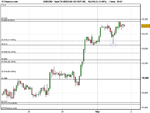a couple of points...
* whether this is of any relevance I don't know, but my chart looked pretty similar to yours Was...Sweepylongblahblahblahblah... I think this is probably due to a couple of things, including a) the hours spent studying the PA, b) we just happen to agree, coincidence, and c) good taste 😉
As for the comments FW makes on your chart, I make the following suggestions
* The "false breakouts" that are highlighted on your chart... clearly whether it is actually a false breakout or not will depend on one's defenition (close above / below, break of high / low etc...). I mention it because different definitions may equally return additional, profitable, opportunities than the losers in this case.
** Secondly, I think part of the issue is that a currency example has been used. On my charts, I mark out pivot points (as I call them; basically horizontal lines where price has turned, and I look for S-> R and vice versa). I do not expect price to react to my levels exactly - the traders driving the price, in the spot and forward markets, don't give a sh!t about what I've got on my chart. They are much more like "flags" to help me determine where abouts a reaction in price is likely to occur, and where abouts I might be able to focus in on the Price Action and pick out an oportunity...
*** With regard to the "pin-bars" highlighted, I follow on from my previous point. Trying to understand the nuances of every tick along the chart is a noble ideal indeed, but rather useless on it;s own. A much harder skill, one that cannot be taught, is how to determine which ticks / whatever are important, and which are not (perhaps they are all important for exactly this) - I use my "flags" to help me with this, others will have different approaches...
What I am trying to say is that, despite all the terminology, rules and definitions that exist (and, I hasten to add, are useful), a large part of successful trading is discretion. The discretion not to take a Pin bar in the middle of nowhere, the discretion to sell off a level that hasn't been fully tested, discretion not to take a break-out trade just because price has crossed my line by a pip. I suspect that is one of the many reasons new traders get frustrated... even though I have clearly defined criteria for taking a trade, I can't take discretion out of the mixer. And you can't teach it or write it down, you just have to practice until it comes.
If one has the skill, in the right market, it is possible to read Price action like a piece of music. The ability to identify general regions of price that are likely to cause a reaction, then watching the price in real time to guage the markets reaction to this region. When it all hooks up together, it seems possible to trade the evolving price action like "3 blind mice" on a recorder, but it sounds like something Mahler wrote. Much is said about discipline, strict entry criteria, trade management, and rightly so. The irony is that these skills, combined with a fair level of experience and discretion, can sometimes lead one to "take price as it comes" and "go with the flow", when all the instruments in your trading orchestra are reading off the same hymn sheet, in tune, and in time.
That is the hallmark of a skillfull trader IMO.
P.S. Apologies for all the mumbo - jumbo... the crux of my point is that you can't automate trading altogether. In all successful traders there is an element of skill and judgement in reading their market. It only comes after bucket loads of eye popping frustration, which is why so many fall before the final fence.





